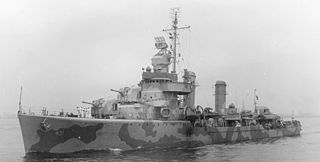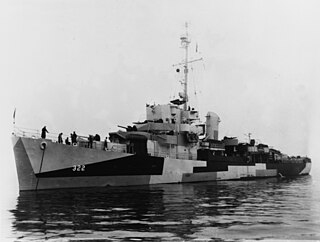
The second USS Hamilton (DD–141) was a Wickes-class destroyer in the United States Navy following World War I, later reclassified DMS-18 for service in World War II.

USS Du Pont (DD–152) was a Wickes-class destroyer in the United States Navy during World War II, later reclassified as AG-80. She was the second ship named for Rear Admiral Samuel Francis Du Pont.

USS Parrott (DD-218) was a Clemson-class destroyer in the United States Navy during World War II and was the second ship named for George Fountain Parrott.

USS Livermore (DD-429), a Gleaves-class destroyer, was the 1st ship of the United States Navy to be named for Samuel Livermore, the first naval chaplain to be honored with a ship in his name.

USS Plunkett (DD-431), a Gleaves-class destroyer, is the only ship of the United States Navy to be named for Rear Admiral Charles Peshall Plunkett.

USS Meredith (DD-434), a Gleaves-class destroyer, was the second ship of the United States Navy to be named for Jonathan Meredith, a United States Marine Corps sergeant who served during the First Barbary War.

USS Ludlow (DD-438), a Gleaves-class destroyer, was the third ship of the United States Navy to bear the name. The second and third Ludlow ships were named for Lieutenant Augustus C. Ludlow, second in command of USS Chesapeake. He was, like his captain, mortally wounded in their ship's engagement with HMS Shannon on 1 June 1813, and died at Halifax, Nova Scotia on 13 June.

USS Emmons (DD-457/DMS-22) was a Gleaves-class destroyer of the United States Navy, named for Rear Admiral George F. Emmons (1811–1884).

USS Forrest (DD-461/DMS-24), was a Gleaves-class destroyer of the United States Navy.

USS Hilary P. Jones (DD-427) was a Benson-class destroyer in the United States Navy during World War II. She was named for Admiral Hilary P. Jones.

USS Bebas (DE-10) was an Evarts-class destroyer escort in the service of the United States Navy from 1943 to 1945.

USS Frederick C. Davis (DE-136) was an Edsall-class destroyer escort built for the United States Navy during World War II. It was the last US Naval vessel lost in the Battle of the Atlantic.

USS Jacob Jones (DE-130) was an Edsall-class destroyer escort built for the U.S. Navy during World War II. She served in the Atlantic Ocean and provided destroyer escort service against submarine and air attack for Navy vessels and convoys.

USS Fessenden (DE-142/DER-142) was an Edsall-class destroyer escort built for the U.S. Navy during World War II. She served in the Atlantic Ocean and the Pacific Ocean and provided destroyer escort protection against submarine and air attack for Navy vessels and convoys.

USS Tomich (DE-242) was an Edsall-class destroyer escort in service with the United States Navy from 1943 to 1946. She was scrapped in 1974.

USS J. Richard Ward (DE-243) was an Edsall-class destroyer escort built for the U.S. Navy during World War II. She served in the Atlantic Ocean the Pacific Ocean and provided destroyer escort protection against submarine and air attack for Navy vessels and convoys. She was named in honor of James Richard Ward who was awarded the Medal of Honor posthumously for his heroic efforts under fire on the USS Oklahoma (BB-37). She was launched by Brown Shipbuilding Co., Houston, Texas, 6 January 1943; sponsored by Miss Marjorie Ward, sister of Seaman First Class Ward; and commissioned 5 July 1943.

USS Newell was an Edsall-class destroyer escort built for the U.S. Navy during World War II. She served in the Atlantic and Pacific Oceans and provided destroyer escort protection against submarine and air attack for Navy vessels and convoys. Post war, she served in various capacities before being finally decommissioned.

USS Haverfield (DE-393) was an Edsall-class destroyer escort built for the U.S. Navy during World War II. She served in the Atlantic Ocean and the Pacific Ocean and provided destroyer escort protection against submarine and air attack for Navy vessels and convoys.

USS Jaccard (DE-355) was a John C. Butler-class destroyer escort acquired by the U.S. Navy during World War II. The primary purpose of the destroyer escort was to escort and protect ships in convoy, in addition to other tasks as assigned, such as patrol or radar picket. Post-war, she returned home with one battle star to her credit.
USS Johnnie Hutchins (DE-360) was a John C. Butler-class destroyer escort acquired by the U.S. Navy during World War II. The primary purpose of the destroyer escort was to escort and protect ships in convoy, in addition to other tasks as assigned, such as patrol or radar picket. She served in the Pacific Ocean, and, post-war, she returned home with a Navy Unit Commendation awarded to her for her battle with Japanese midget submarines on 9 August 1945.



















